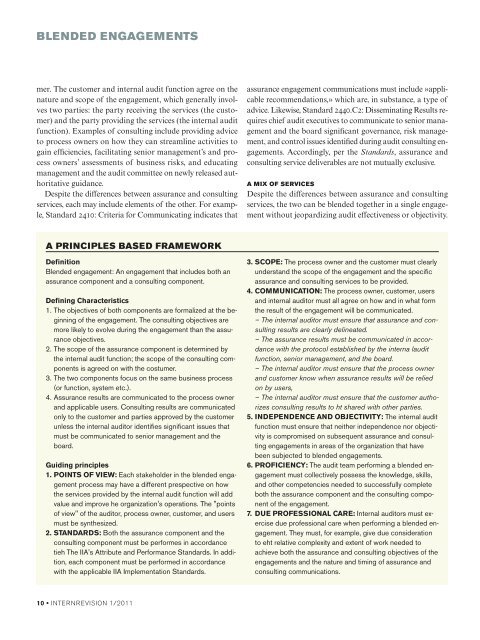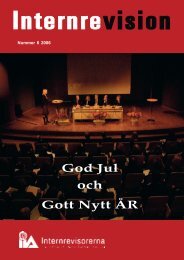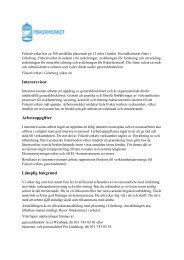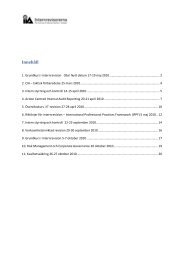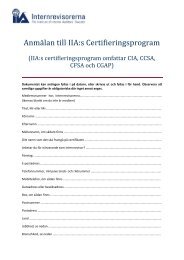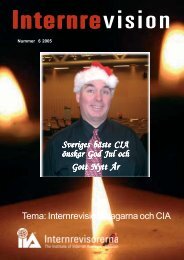#1/2011 - Internrevisorerna - Hem
#1/2011 - Internrevisorerna - Hem
#1/2011 - Internrevisorerna - Hem
You also want an ePaper? Increase the reach of your titles
YUMPU automatically turns print PDFs into web optimized ePapers that Google loves.
BLENDED ENGAGEMENTS<br />
mer. The customer and internal audit function agree on the<br />
nature and scope of the engagement, which generally involves<br />
two parties: the party receiving the services (the customer)<br />
and the party providing the services (the internal audit<br />
function). Examples of consulting include providing advice<br />
to process owners on how they can streamline activities to<br />
gain efficiencies, facilitating senior management’s and process<br />
owners’ assessments of business risks, and educating<br />
management and the audit committee on newly released authoritative<br />
guidance.<br />
Despite the differences between assurance and consulting<br />
services, each may include elements of the other. For example,<br />
Standard 2410: Criteria for Communicating indicates that<br />
A PRINCIPLES BASED FRAMEWORK<br />
Definition<br />
Blended engagement: An engagement that includes both an<br />
assurance component and a consulting component.<br />
Defining Characteristics<br />
1. The objectives of both components are formalized at the beginning<br />
of the engagement. The consulting objectives are<br />
more likely to evolve during the engagement than the assurance<br />
objectives.<br />
2. The scope of the assurance component is determined by<br />
the internal audit function; the scope of the consulting components<br />
is agreed on with the costumer.<br />
3. The two components focus on the same business process<br />
(or function, system etc.).<br />
4. Assurance results are communicated to the process owner<br />
and applicable users. Consulting results are communicated<br />
only to the customer and parties approved by the customer<br />
unless the internal auditor identifies significant issues that<br />
must be communicated to senior management and the<br />
board.<br />
Guiding principles<br />
1. POINTS OF VIEW: Each stakeholder in the blended engagement<br />
process may have a different prespective on how<br />
the services provided by the internal audit function will add<br />
value and improve he organization's operations. The "points<br />
of view" of the auditor, process owner, customer, and users<br />
must be synthesized.<br />
2. STANDARDS: Both the assurance component and the<br />
consulting component must be performes in accordance<br />
tieh The IIA's Attribute and Performance Standards. In addition,<br />
each component must be performed in accordance<br />
with the applicable IIA Implementation Standards.<br />
10 • INTERNREVISION 1/<strong>2011</strong><br />
assurance engagement communications must include »applicable<br />
recommendations,» which are, in substance, a type of<br />
advice. Likewise, Standard 2440.C2: Disseminating Results requires<br />
chief audit executives to communicate to senior management<br />
and the board significant governance, risk management,<br />
and control issues identified during audit consulting engagements.<br />
Accordingly, per the Standards, assurance and<br />
consulting service deliverables are not mutually exclusive.<br />
A MIX OF SERVICES<br />
Despite the differences between assurance and consulting<br />
services, the two can be blended together in a single engagement<br />
without jeopardizing audit effectiveness or objectivity.<br />
3. SCOPE: The process owner and the customer must clearly<br />
understand the scope of the engagement and the specific<br />
assurance and consulting services to be provided.<br />
4. COMMUNICATION: The process owner, customer, users<br />
and internal auditor must all agree on how and in what form<br />
the result of the engagement will be communicated.<br />
– The internal auditor must ensure that assurance and consulting<br />
results are clearly delineated.<br />
– The assurance results must be communicated in accordance<br />
with the protocol established by the interna laudit<br />
function, senior management, and the board.<br />
– The internal auditor must ensure that the process owner<br />
and customer know when assurance results will be relied<br />
on by users,<br />
– The internal auditor must ensure that the customer authorizes<br />
consulting results to ht shared with other parties.<br />
5. INDEPENDENCE AND OBJECTIVITY: The internal audit<br />
function must ensure that neither independence nor objectivity<br />
is compromised on subsequent assurance and consulting<br />
engagements in areas of the organization that have<br />
been subjected to blended engagements.<br />
6. PROFICIENCY: The audit team performing a blended engagement<br />
must collectively possess the knowledge, skills,<br />
and other competencies needed to successfully complete<br />
both the assurance component and the consulting component<br />
of the engagement.<br />
7. DUE PROFESSIONAL CARE: Internal auditors must exercise<br />
due professional care when performing a blended engagement.<br />
They must, for example, give due consideration<br />
to eht relative complexity and extent of work needed to<br />
achieve both the assurance and consulting objectives of the<br />
engagements and the nature and timing of assurance and<br />
consulting communications.


